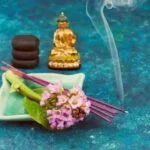Aromatherapy oils, also known as essential oils, are widely used for their therapeutic purposes. In this article, we will explore the concept of aromatherapy and delve into the various ways in which these oils can be utilized for healing and relaxation. As more people seek natural remedies and holistic approaches to well-being, the popularity of aromatherapy and essential oils has significantly increased.
Aromatherapy is a practice that involves the use of essential oils to promote physical, emotional, and psychological well-being. These oils are extracted from plants, flowers, and herbs through methods such as steam distillation or cold-press extraction. They contain the concentrated essence of the plant’s fragrance and are highly potent in their effects.
For centuries, different cultures around the world have harnessed the power of essential oils for various purposes. In ancient Egypt, aromatic botanicals were used in religious rituals and embalming practices. Traditional Chinese medicine incorporated essential oils for their therapeutic properties. The Greeks and Romans utilized these oils for massage therapy and bathing rituals. Today, aromatherapy continues to gain recognition as an alternative form of medicine due to its potential benefits.
Using aromatherapy oils can provide numerous advantages for individuals seeking improved overall well-being. These include stress relief, improved sleep quality, pain management, mood enhancement, and support for the immune system. By exploring specific types of essential oils such as lavender, peppermint, eucalyptus, tea tree, and chamomile – each with their own unique properties – we can discover how they effectively address various concerns.
In the following sections of this article, we will further explore the history of aromatherapy and how it has evolved over time. Additionally, we will discuss different types of aromatherapy oils available today and how they are extracted from natural sources.
Furthermore, we will delve into specific uses of these oils in areas such as stress management, respiratory health care,s skin care, and pain relief. Finally, we will also discuss important safety considerations to ensure that individuals can use aromatherapy oils safely and effectively.
By the end of this article, readers will have a comprehensive understanding of aromatherapy oils and their potential benefits for holistic well-being. We encourage you to continue reading to delve deeper into this fascinating world of natural healing.
History of Aromatherapy
Ancient Origins of Aromatherapy
The history of aromatherapy can be traced back thousands of years to ancient civilizations such as Egypt, China, India, and Greece. These cultures recognized the therapeutic properties of plants and used them in various forms for healing and relaxation purposes, laying the foundation for modern aromatherapy practices.
In Ancient Egypt, essential oils were highly prized and widely used in religious ceremonies, cosmetics, and embalming processes. The famous Ebers Papyrus, dating back to around 1500 BCE, contains detailed recipes for medicinal ointments and aromatic oils. Egyptians believed that inhaling different scents could harmonize the body and balance emotions.
Similarly, in China and India, the use of aromatic plants and herbs in healing practices was well-established. The concept of balancing one’s life force or energy (known as qi or prana) with the help of essential oils was a key principle in Traditional Chinese Medicine and Ayurveda. Aromatic substances such as sandalwood, cinnamon, frankincense, and myrrh were commonly employed in rituals, massage therapies, and herbal remedies.
Revival of Aromatherapy in Modern Times
Although aromatherapy has ancient roots, it experienced a revival during the early 20th century thanks to the efforts of notable individuals such as René-Maurice Gattefossé and Marguerite Maury. Gattefossé is often credited with coining the term “aromatherapy” after he accidentally discovered the healing properties of lavender oil when treating a burn injury.
During this time period, advancements in technology made it possible to extract essential oils more efficiently through methods like steam distillation. This allowed for wider accessibility to these natural remedies.
Marguerite Maury further popularized aromatherapy by developing specific methods for applying essential oils topically on the skin. She believed that essential oils, when properly used, could enhance overall well-being and address various physical and emotional imbalances.
Today, aromatherapy continues to evolve as a holistic practice that incorporates ancient wisdom with modern scientific research. The rich history of using essential oils for healing and relaxation serves as a testament to the enduring power and effectiveness of this natural approach to well-being.
Understanding Aromatherapy Oils
Aromatherapy oils are derived from various plants, flowers, and herbs through a process known as extraction. There are different types of aromatherapy oils, each with its own unique properties and therapeutic benefits. Understanding the various types of aromatherapy oils and their extraction methods can help individuals choose the right oil for their specific needs.
Types of Aromatherapy Oils
There is a wide variety of aromatherapy oils available, each offering distinct aromas and healing properties. Some commonly used essential oils include lavender, peppermint, eucalyptus, tea tree, and chamomile. These essential oils are extracted from different parts of the plant such as leaves, flowers, stems or roots.
Extraction Methods
Aromatherapy oils are extracted through various methods to capture their beneficial properties. One common method is steam distillation where plant material and water are heated to produce steam which passes through the plant material and carries the volatile compounds with it. The steam is then condensed to separate the oil from the water. Cold-press extraction is another method commonly used for citrus-based essential oils where mechanical pressure is applied to the fruit peel to release the oil.
Pure vs. Synthetic Oils
It’s important to note that not all aromatherapy oils on the market are pure or natural. Synthetic fragrances may be labeled as “aromatherapy” but do not offer the same therapeutic benefits as true essential oils. Pure essential oils are derived directly from plants without any added chemicals or synthetic ingredients. When purchasing aromatherapy oils, it is recommended to look for reputable brands that guarantee purity and provide information about extraction methods on their packaging or website.
Understanding different types of aromatherapy oils and how they are extracted can help individuals make informed choices when incorporating them into their wellness routines. Whether diffusing them in the home, using them in massage oils, or applying them topically, aromatherapy oils provide a natural and holistic approach to relaxation and healing.
Benefits of Aromatherapy Oils
Aromatherapy oils offer a wide range of benefits for both physical and emotional well-being. These oils can be used to promote relaxation, improve sleep quality, manage pain, enhance mood, and even support the immune system. By understanding these benefits, individuals can harness the power of aromatherapy oils to improve their overall health and wellness.
One key benefit of aromatherapy oils is stress relief. Aromatherapy has long been recognized as an effective method for reducing stress and anxiety. Certain essential oils have calming properties that can help relax the mind and body, such as lavender, chamomile, and rose. These scents can be inhaled or used topically to promote relaxation and reduce feelings of stress.
Another benefit of aromatherapy oils is improved sleep. Many people struggle with falling asleep or maintaining a deep sleep throughout the night. Essential oils like lavender and vanilla have been shown to promote relaxation and create a calming environment conducive for sleep. Diffusing these oils in the bedroom or using them in a bedtime bath can help individuals achieve a more restful night’s sleep.
In addition to stress relief and improved sleep, aromatherapy oils can also be used for pain management. Certain essential oils have analgesic properties that help reduce pain sensations. Peppermint oil is known for its cooling effect which soothes sore muscles while eucalyptus oil can provide relief from respiratory issues like congestion. By topically applying these oils or using them in massage therapy, individuals can find natural relief from various types of discomfort.
Furthermore, aromatherapy oils are known for their mood-enhancing effects. Scents like citrus fruits (such as lemon and orange) are uplifting and energizing while others such as ylang-ylang or bergamot have calming properties that combat feelings of sadness or anxiety. By incorporating these mood-enhancing scents into their daily routine through diffusers or inhalation techniques, individuals can improve their emotional well-being and enjoy a more positive outlook on life.
Lastly, aromatherapy oils can provide support for the immune system. Certain essential oils have antifungal and antimicrobial properties that can help protect against harmful bacteria and viruses. Tea tree oil, for example, is known for its germ-fighting abilities while eucalyptus oil has been used to treat respiratory infections. By diffusing these oils or using them in homemade cleaning products, individuals can create an environment that promotes good health and well-being.
Popular Types of Aromatherapy Oils
Aromatherapy is a popular practice that involves the use of essential oils for therapeutic purposes. There are numerous types of aromatherapy oils available, each with their own unique properties and uses. In this section, we will explore some of the most commonly used aromatherapy oils and discuss their specific benefits.
- Lavender oil: Lavender is one of the most versatile and widely used essential oils in aromatherapy. It has a calming and relaxing effect on both the mind and body, making it beneficial for stress relief and promoting better sleep. Lavender oil is also known for its soothing properties, making it an excellent choice for reducing skin irritation and promoting wound healing.
- Peppermint oil: Peppermint oil has a refreshing and invigorating scent that can help to improve focus and mental clarity. It is commonly used to boost energy levels, relieve headaches, and ease digestive discomfort. The cooling sensation of peppermint oil also makes it useful for alleviating muscle pain or tension.
- Eucalyptus oil: Eucalyptus oil is well-known for its respiratory benefits. It has expectorant properties that can help to clear congestion in the chest and sinuses, making it useful for treating colds, coughs, and respiratory infections. Eucalyptus oil also has antibacterial properties, which may contribute to its effectiveness in supporting immune health.
- Tea tree oil: Tea tree oil is highly regarded for its antimicrobial properties, making it an effective natural remedy for acne-prone skin or fungal infections such as athlete’s foot or nail fungus. It can also be used topically to soothe insect bites or small cuts due to its anti-inflammatory properties.
- Chamomile oil: Chamomile oil is renowned for its calming effects on both the mind and body. It is often used to promote relaxation, relieve anxiety or depression, and aid in better sleep. Chamomile oil can also be beneficial for soothing skin irritation or inflammation, making it suitable for sensitive or problematic skin.
It is important to note that these are just a few examples of popular aromatherapy oils, and there are many others available with their own unique properties and uses. When using aromatherapy oils, it is important to follow proper dilution guidelines and consider any potential allergies or sensitivities. Experimenting with different oils can help individuals find the ones that work best for their specific needs and preferences.
Aromatherapy Techniques and Applications
Aromatherapy oils can be used in a variety of ways to harness their therapeutic benefits and enhance well-being. The following are some popular techniques and applications for using these oils:
- Diffusing: One of the most common methods for using aromatherapy oils is through diffusion. This involves dispersing the oil into the air using a diffuser or aromatherapy burner. This allows the scent to be inhaled, providing both physical and emotional benefits. Diffusing oils can create a relaxing environment, promote better sleep, alleviate stress, purify the air, and even ward off insects.
- Inhalation: Inhaling the aroma of essential oils directly from the bottle or by placing a few drops on a tissue or cloth is another effective technique. This method allows the oil molecules to enter the respiratory system and reach the bloodstream quickly, providing immediate benefits. Inhalation can help relieve congestion and respiratory issues, improve focus and concentration, uplift mood, and support mental clarity.
- Topical Application: Applying aromatherapy oils topically is an excellent way to experience their healing properties directly on the skin. However, it’s important to note that essential oils are highly concentrated and should not be applied directly without dilution with a carrier oil like almond oil or coconut oil.
Some common areas for topical application include temples (for headaches), pulse points (for relaxation), muscles (for pain relief), and abdomen (for digestive issues). Topical application can also be incorporated into massage therapy by adding a few drops of aromatherapy oil to a carrier oil. - Bathing: Adding essential oils to bathwater elevates the bathing experience by creating a soothing and aromatic environment. Simply add a few drops of your chosen oil to warm bathwater and enjoy a relaxing soak. This method allows the body to absorb the therapeutic properties of the oils through the skin, helping to relieve stress, relax muscles, improve circulation, and promote deep relaxation and sleep.
| Technique/Application | Description |
|---|---|
| Diffusing | Dispersing oils into the air for inhalation. |
| Inhalation | Inhaling oils directly or through a cloth for immediate benefits. |
| Topical Application | Diluting oils with a carrier oil and applying them directly on the skin. |
| Bathing | Adding essential oils to bathwater for absorbed relaxation. |
Specific Uses of Aromatherapy Oils
Aromatherapy oils are widely used for a variety of purposes, and their specific uses can provide targeted relief and support in various situations. One of the most common applications of aromatherapy oils is stress and anxiety management. Certain essential oils, such as lavender and chamomile, have calming properties that can help reduce feelings of tension and promote relaxation. These oils can be diffused in a room, applied topically to pulse points, or added to bathwater for a soothing effect.
In addition to stress relief, aromatherapy oils also offer benefits for skin care. Many essential oils have antimicrobial and anti-inflammatory properties that can help treat acne, soothe irritation, and promote overall skin health. Tea tree oil, for example, is often used in natural skincare products due to its ability to combat bacteria on the skin’s surface.
Aromatherapy oils are also beneficial for respiratory health. Eucalyptus oil is well-known for its decongestant properties and is often used to alleviate symptoms of colds, coughs, and sinus congestion. Similarly, peppermint oil has a cooling effect that can help clear nasal passages and relieve respiratory discomfort.
Headaches and muscle pain can also be effectively managed with the use of aromatherapy oils. Peppermint oil has analgesic properties that may provide temporary relief from headaches when applied topically to the temples or forehead. Additionally, certain essential oils like lavender and chamomile may help reduce muscle tension when used in massage or bath blends.
| Uses | Aromatherapy Oils |
|---|---|
| Stress relief | Lavender, Chamomile |
| Skin care | Tea Tree, Lavender |
| Respiratory health | Eucalyptus, Peppermint |
| Headache relief | Peppermint, Lavender, Chamomile |
| Muscle pain relief | Lavender, Chamomile, Eucalyptus |
It is important to note that while aromatherapy oils offer numerous benefits, caution should be exercised when using them. Essential oils are highly concentrated and should be diluted properly before topical application to avoid skin irritation or sensitivity.
It is also recommended to perform a patch test prior to using any new essential oil to check for potential allergies. Pregnant women, children, and individuals with certain medical conditions should consult with a healthcare professional before incorporating aromatherapy oils into their routine.
Safety Considerations
When using aromatherapy oils, it is crucial to prioritize safety and be aware of potential risks. While essential oils can offer numerous benefits, improper use or excessive amounts can lead to adverse reactions. One important safety consideration when using aromatherapy oils is the necessity for proper dilution.
Essential oils are highly concentrated substances, and applying them directly to the skin without dilution can cause irritation or even burns. It is recommended to always mix essential oils with a carrier oil such as sweet almond oil or coconut oil before applying them topically.
Furthermore, it is essential to be mindful of potential allergies or sensitivities to certain aromatherapy oils. Some individuals may have allergic reactions or experience sensitivity to specific essential oils. It is advised to conduct a patch test before applying any new essential oil topically.
This involves diluting a small amount of the oil in a carrier oil and applying it to a small area of skin, such as the inner forearm. If no reaction occurs within 24 hours, it is generally safe to use that particular oil.
Additionally, pregnant women, children, and individuals with certain medical conditions should exercise caution when using aromatherapy oils. Certain essential oils may not be suitable for these groups due to their potent nature or potential hormonal effects. It is recommended for pregnant women and those with underlying health conditions to consult with a qualified healthcare professional before incorporating aromatherapy into their wellness routines.
Conclusion
In conclusion, aromatherapy oils offer a wide range of benefits and uses for improving overall well-being. From stress relief to pain management, these oils have been used for centuries in different cultures for their therapeutic properties. The popularity of aromatherapy and essential oils has surged in recent years as more people seek natural and holistic approaches to their health.
By exploring the history and origins of aromatherapy, it becomes clear that these oils have stood the test of time and have been revered for their healing powers throughout the ages. The extraction process of these oils from plants, flowers, and herbs ensures that their potent properties are preserved, providing users with a concentrated form of natural healing.
One of the key advantages of using aromatherapy oils is their versatility. With various methods of application such as diffusing, inhalation, topical use, or adding them to bathwater or massage oils, individuals can customize their experience based on personal preferences and desired outcomes. Whether it’s managing stress and anxiety, improving respiratory health, relieving headaches or muscle pain, or enhancing sleep and mood, there is an aroma oil that can effectively address these concerns.
As with any natural remedy, safety considerations must be taken into account when using aromatherapy oils. Dilution guidelines should be followed to prevent skin irritation or adverse reactions. It’s also important to be mindful of potential allergies or sensitivities individuals may have to particular oils. Consulting with a qualified aromatherapist or conducting thorough research before incorporating these oils into one’s self-care routine is recommended.
In summary, aromatherapy oils hold tremendous potential in promoting physical and emotional well-being. With their myriad uses and multitude of benefits ranging from stress relief to improved sleep quality, essential oils provide individuals with a natural alternative for achieving optimal health. By taking a holistic approach through exploring the world of aromatherapy oils, readers can enhance their overall wellness while enjoying the beautiful scents derived from nature’s botanicals.
Frequently Asked Questions
What is the difference between essential oils and aromatherapy?
The main difference between essential oils and aromatherapy lies in their purpose and application. Essential oils are concentrated extracts obtained from plants that retain the characteristic fragrance, or essence, of the plant they originated from. These oils are versatile and can be used for various purposes beyond just aromatherapy, such as in skincare, cleaning products, or as natural remedies.
On the other hand, aromatherapy refers specifically to the therapeutic use of essential oils to improve physical, emotional, and mental well-being. Aromatherapy involves inhaling or applying diluted essential oils through methods like diffusers, inhalers, massage oils, or bath salts.
How do you use essential aromatherapy oils?
There are several ways to use essential aromatherapy oils depending on your preference and desired effects. One common method is through inhalation using a diffuser or by placing a few drops of oil onto a cloth or tissue and inhaling deeply. This allows the scent molecules to enter the nasal passages and stimulate the olfactory system for emotional and mental benefits.
Another way is through topical application by diluting the oils with a carrier oil like coconut or jojoba oil before massaging onto the skin. This method can provide localized relief for muscle tension or skin conditions. Additionally, you may add a few drops of essential oil into bathwater for a soothing aromatic bath experience.
Can you use aromatherapy oils on your body?
Yes, aromatherapy oils can be safely used on the body when diluted properly with a suitable carrier oil before applying directly to the skin. It’s important to note that most essential oils should not be used undiluted as they are highly concentrated and might cause irritation or sensitization reactions in some individuals. Diluting essential oils in a carrier oil helps spread them over a larger area while minimizing any potential adverse effects on the skin.
Popular carrier oils include almond oil, grapeseed oil, or olive oil among others. When using carefully selected essential oils topically, they can offer various benefits like relaxation, tension relief, or skincare benefits, depending on the specific oil being used. However, it’s always advisable to perform a patch test on a small area of skin first to check for any adverse reactions before applying more extensively.

Are you looking for a natural way to improve your health and wellbeing?
If so, aromatherapy may be the answer for you.






